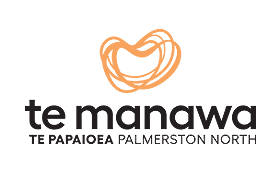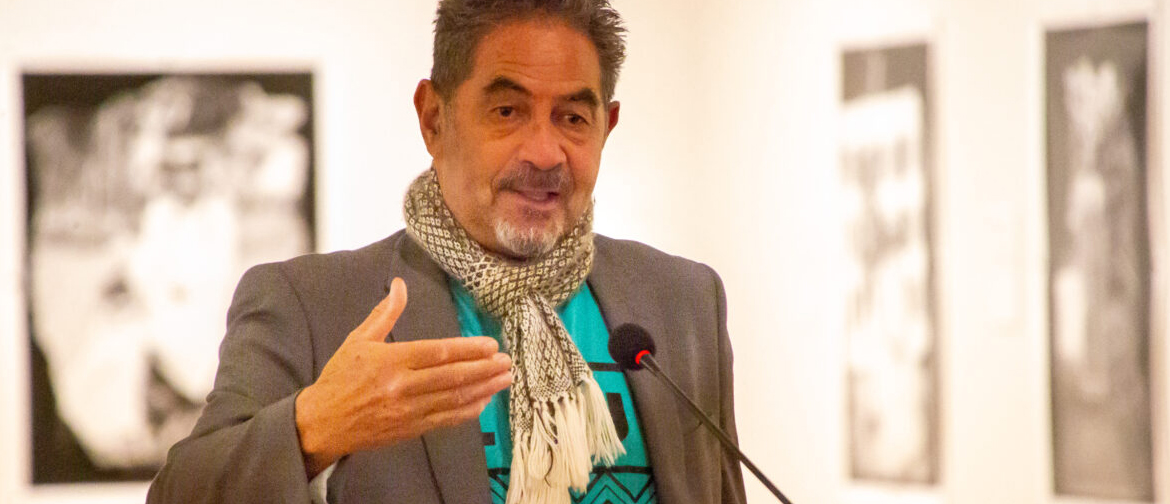Associate Professor Hone Morris speaks at a Te Manawa exhibition opening in July 2022. Photo by David Wiltshire.
Visitors to any exhibition at Te Manawa are very likely to have encountered the work of Associate Professor, Senior Scholar Hone Morris from Massey University. He’s not an artist – at least, not one who paints pictures or creates sculptures. Yet there is artistry to what he does, and for many years it has graced the galleries, making visitors feel welcome.
Over the years Associate Professor Morris has translated vast amounts of exhibition text into Te Reo Māori. Since becoming a licensed interpreter and translator almost 20 years ago, he’s worked with Government departments, NGOs and Te Manawa to raise the profile of one of the country’s official languages in public life. He’s noticed a huge increase in the demand for translation services as more organisations adopt a bilingual approach.
“It normalises Te Reo Māori, makes it more seen and heard,” he says. “I want to create translations that students of Te Reo, kura kaupapa Māori schools and Māori media can easily follow. I don’t get too technical with the translations I use, and hopefully the words around the technical terms assist those who are learning Te Reo.”
But some exhibitions at Te Manawa get deep into the science of their subjects, and at first glance some complex terms might seem to defy expression in Te Reo. How does a translator tackle things like “electromagnetic spectrum” from the Museum’s Sunlight – Ihi Kōmaru exhibition? Or “refraction index” from Mirror Magic? Associate Professor Morris, fresh from translating a book of Chilean poetry from English to Te Reo, is no stranger to such challenges.
“I was told a few years back by a kaumātua that there’s nothing in this world that can’t be translated into Te Reo Māori, and that there’s nothing that can’t be given a Māori perspective,” he says. “And in that respect there’ve been a lot of dictionaries that have come out – some published by He Kupenga Hao i te Reo right here in Papaioea – that are focused on specific areas. Groups of fluent speakers get together and create new words, or look at the origin of the English word and then give a Māori word based on the Māori perspective of the world.”
For anybody wondering, the Māori term for “electromagnetic spectrum” is “tūāwhiorangi autōhiko” – literally “a rainbow (spectrum) of magnetic power”.
Associate Professor Morris says the work has become easier across the thirty or more years he’s been working in Te Reo.
“Usually I work on the first words that were created by our ancestors and the first interaction with the English language and the settlers that came to Aotearoa. There are modern words too, that have been created lately. We had a word that we used for Covid that came out of the Spanish Flu back in 1918. Words like ‘radiation’ are used a lot at the moment, with the whole idea of climate change and nuclear possibilities.”
He notes that Māori has a lot of loan words from English, but English also has words taken from Te Reo. Remember the last time you walked through the weeds and got lots of spiky seeds attached to your socks? “Biddybids”, he explains , is an Anglicisation of the word “piripiri”, the Māori word meaning “to cling”.
Context is important when approaching the text of exhibition panels. Whether the subject is biographical, scientific or historical informs the kind of language that best translates it. Yet the nature of Te Reo will always tie these different styles together.
“Māori is a picture language in a lot of ways,” says Associate Professor Morris, “it uses a lot of metaphor, analogy, simile and onomatopoeia. These literary devices are strong in Te Reo Māori.”
Te Manawa has recently upgraded its conservatory with interpretive text panels giving details of the plants and animals that live there. All of these are bilingual; students of Te Reo may compare and contrast the language used there with that in the Art Gallery.
Associate Professor Morris looks forward to the expansion of the Kiwi vernacular to include more Te Reo.
“Ninety per cent of Kiwis know what words like “kai”, “hui” and “whānau” mean,” he says. In the last couple of years, Covid updates have added phrases like “across the motu” to common usage. The hope is that visiting bilingual exhibitions will over time have a similar effect.
“I’m always excited to promote Te Reo Māori through that medium.”




